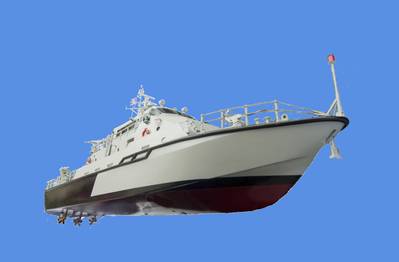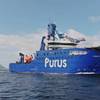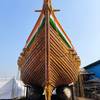Industrial Strength Patrol Boat
At a time when the nations of the world are struggling to provide marine security in an era of fiscal responsibility, Thailand’s Marsun Company Ltd. has come up with an industrial strength response.
The shipyard’s 36-meter crew boat design is a well-proven vessel that typically spends 30 days at sea and returns to port only for crew change. The crew boat can do this year round due to a very robust build with equally robust components. Down time is lost revenue for a commercial vessel.
Marsun’s design engineer Khun Sampope explained that the patrol boat version, of which three have been ordered, uses the same 36 by 7.6 meter hull form as the crew boat and the same 3.6-meter molded depth, but with a modified superstructure. “We made very minor changes in the hull and the superstructure added very little weight. This was not enough to effect any of the stability calculations.”
The modified version, with 63 square meters of clear deck space retains much of the crew boat’s large 67 square meter after deck. This will give the patrol boat the same 50-ton load capacity and allow the vessel to carry two 20-foot containers on the aft deck should the need arise. This gives the vessel significant flexibility for search and rescue capabilities not found on most patrol vessels of this size. The aft deck is also designed to mount surface-to-surface missiles. The forward deck is designed to install a 30/20 mm machine gun. Additional flexible space is designed in to provide a control system command room in future.
One of the more significant modifications of the crew boat design was made to meet the navy’s requirement for a maximum speed in excess of 27 knots. The crew boat’s three Cummins 1350 HP KTA38-M2 engines give that boat a maximum speed in excess of 24 knots. Staying with Cummins fuel-efficient reliability the Marsun designers specified Cummins KTA50-M main engines each delivering 1800 HP at 1900 RPM. The larger engines and superstructure added weight to the boat, however the crew boat’s fuel oil and water cargo tanks were not required with the result that the patrol boat can actually be lighter than the crew boat. Additionally with the larger engines located closer to the boat’s baseline, the vessel’s center of gravity is lower than in her sister hull.
While a crew boat takes on passengers, up to 97 on Marsun’s recent deliveries, a patrol boat is designed with additional weight as integral. The larger superstructure provides full accommodation for 28 crewmembers (with space for an additional officer) and up to 13 special operation forces. The resulting design provides more comfortable space for the crew than is often the case on patrol vessels. To meet the electrical requirements of a patrol boat, the Marsun designers have increased the electrical generators from a pair of Cummins powered 85 kW generators to pair of Cummins powered 112 kW sets. The vessel has an endurance range of 1200 nautical miles.
The success of the Marsun 36-meter patrol boat reflects the years of private sector design in-put while embodying the careful modifications by Marsun. “This vessel gives up nothing in terms of performance, but by working with a crewboat design we have been able work with a proven design and, at the same time, pass on significant savings on the cost of the vessel,” explained Marsun’s Khun Sampope.
In late June, Admiral Surasak of the Royal Thai Navy presided over a keel laying ceremony for the first three of the 36-meter patrol boats. In the presence of ten Buddhist monks, he placed garlands and ribbons on the prepared bow forms. The first of the patrol boats will launch in mid 2013. In the meantime, Marsun staff are actively consulting with foreign governments on further orders.















